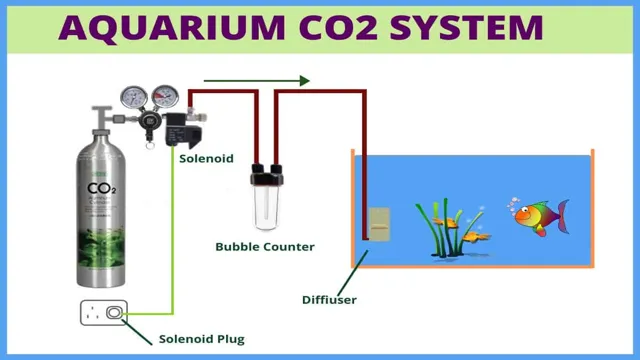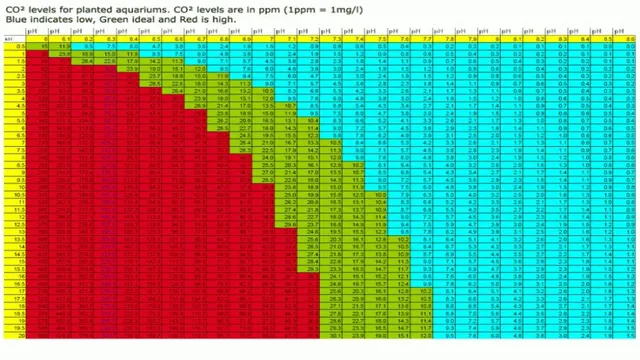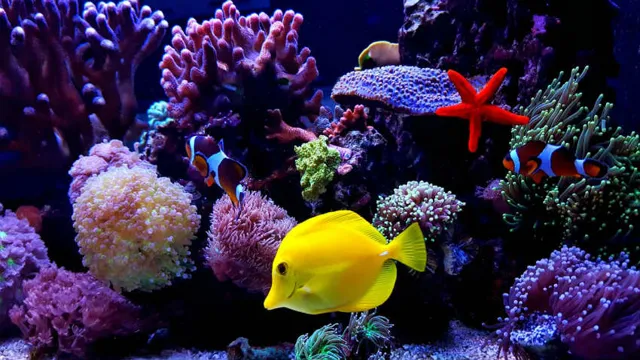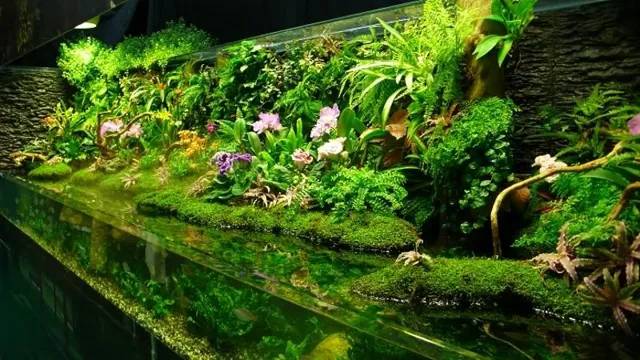Have you noticed your aquarium’s CO2 levels rising lately? This can be a common issue for fish keepers, but luckily there are effective ways to lower those levels and ensure a healthy environment for your aquatic pets. With the right techniques and tools, you can create a well-balanced and thriving ecosystem in your tank. In this blog post, we will go over some tips and tricks for lowering CO2 levels in your aquarium, from adjusting lighting to implementing specific plants.
So, let’s dive into the world of aquarium care and discover how to maintain a healthy and vibrant underwater environment.
Understanding the Importance of CO2
If you’re an aquarium hobbyist, it’s vital to understand the importance of CO2 in your tank. CO2 is essential for the survival of aquatic plants and fish. Without sufficient levels, plants won’t photosynthesize properly, leading to poor growth, algae overgrowth, and even death.
On the other hand, elevated levels of CO2 can harm your aquatic creatures, leading to respiratory distress and even fatalities. To balance CO2 levels, you can consider using CO2 injection systems that regulate the CO2 concentration. However, first, you must determine the ideal concentration level for your aquatic ecosystem since different tank setups require varying levels of CO
Bear in mind that too much or too little CO2 can negatively impact your tank inhabitants. Always monitor your CO2 levels to ensure they remain within safe limits to prevent any harm to your aquatic pets.
Why Too Much CO2 is Bad for Your Aquarium
CO2, aquarium CO2 is an essential element when it comes to maintaining a healthy aquarium, as it promotes plant growth, photosynthesis and helps maintain pH levels. However, it’s crucial to understand that too much CO2 can also have a detrimental impact on your aquarium’s ecosystem. High levels of CO2 can lead to decreased oxygen levels and cause fish to become stressed, resulting in poor health and even death.
Additionally, an excess of CO2 can cause your water to become acidic, leading to corrosion of equipment and a decline in overall aquarium health. Consequently, it’s essential to maintain balanced CO2 levels through proper monitoring and regulating equipment. By understanding the importance of CO2 and its potential side effects, you can create a healthy and thriving environment for your aquatic pets.

Check Your pH Levels
As aquarium enthusiasts, we all want to provide our fish with the best possible habitat that mimics their natural environment. One essential factor to consider when setting up an aquarium is the pH level. In simple terms, pH refers to a measure of how acidic or alkaline the water is on a scale of 1 to 14, with 7 being neutral.
Most freshwater fish do well in a pH range of 5 to 5, while saltwater fish prefer a more alkaline environment in the range of
1 to However, it’s not just about maintaining the right pH level.
It’s crucial to understand the role of CO2 in the aquarium, which directly affects the pH level. Carbon dioxide is a natural byproduct of respiration by fish, plants, and microorganisms in the aquarium. If CO2 levels are too high, it can cause a drop in pH levels, making the water more acidic. (See Also: How to Go to Lotte World Aquarium: A Comprehensive Guide for Ultimate Fun)
That’s why adding live plants to the aquarium is highly recommended as they consume CO2 and produce oxygen through photosynthesis. Keeping a reliable carbon dioxide monitor is a great way to ensure that CO2 levels remain stable and that the pH level is within the optimal range for your fish. By maintaining proper CO2 and pH levels, you’ll provide a healthy and thriving environment for your aquatic pets.
Ways to Lower CO2 Levels in Your Aquarium
Are you struggling with high CO2 levels in your aquarium? It’s important to maintain optimal levels for the health of your aquatic pets and plants. Here are some ways to lower CO2 levels in your aquarium: increase aeration through the use of an air stone or powerhead, add more plants to absorb excess CO2, reduce feeding to decrease organic waste, and perform regular water changes to remove built-up CO Another option is to use a CO2 scrubber or reactor to remove excess CO2 directly from the water.
By implementing these strategies, you can maintain a healthy and balanced ecosystem in your aquarium. Don’t let high CO2 levels harm your aquatic pets and plants – take action today to lower those levels.
Reduce Light Intensity and Duration
Reducing the intensity and duration of light exposure is one of the most effective ways to decrease CO2 levels in your aquarium. Carbon dioxide is produced by fish and plants during respiration, and it is also a byproduct of organic decomposition. While plants use CO2 for photosynthesis during daylight hours, excess CO2 can harm fish, cause algae blooms, and lead to a drop in aquarium pH.
To avoid these problems, you can use low-intensity aquarium lights for shorter periods each day. This will reduce the amount of CO2 produced by photosynthesis and respiration, while still providing enough light for healthy plant growth. Additionally, you can provide shading in the aquarium to limit the amount of light that reaches the water.
This can be done by using aquarium decorations, floating plants, or a screen to reduce the light intensity and duration further. By doing so, you can create a healthier and more balanced aquarium environment for your fish and plants.
Increase Surface Agitation
If your aquarium is suffering from high CO2 levels, one effective way to lower them is by increasing surface agitation. Surface agitation helps to break the surface tension of the water, allowing for better gas exchange between the air and water. As a result, CO2 levels are reduced and oxygen levels are increased.
There are several ways to increase surface agitation in your aquarium, including adding a powerhead, an air stone, or simply adjusting the flow of your filter. By incorporating one of these methods into your aquarium maintenance routine, you can maintain optimal CO2 and oxygen levels for your aquatic inhabitants. So, give your aquarium’s surface a little extra agitation and watch your fish thrive!
Add Live Plants
If you’re looking to lower CO2 levels in your aquarium, adding live plants is a great solution. Plants absorb CO2 as part of photosynthesis and release oxygen, which can help lower the carbon dioxide levels in your tank. Adding live plants not only helps with oxygen levels but also provides a natural and healthy habitat for fish and aquatic creatures.
Moreover, plants also help to remove harmful chemicals and toxins from the water, keeping it clean and healthy. Some great options for live plants in aquariums include Java moss, Amazon sword, and Anubias. Remember to choose plants that are suitable for the size of your tank, lighting conditions, and water parameters. (See Also: How to Build a Nano Marine Aquarium: The Ultimate Guide for Beginners)
Adding live plants to your aquarium can be a simple yet effective solution to lower CO2 levels and improve the overall health of your aquatic ecosystem.
Maintaining Optimal CO2 Levels
Maintaining optimal CO2 levels in an aquarium is crucial for keeping your fish healthy and happy. If the CO2 levels are too high, it can cause stress and even death to your fish, but if they are too low, your plants can suffer. So, how do you lower CO2 levels in an aquarium? One solution is to increase the surface agitation by adding an air stone or a powerhead.
This will increase the exchange of CO2 with oxygen and lower the levels in your aquarium. Another solution is to change the water regularly, especially if you have a heavily planted tank. Plants consume CO2 during photosynthesis, so if you have a lot of them, they could be using up the available CO
Finally, if all else fails, you can use a CO2 scrubber to remove excess CO2 from your tank. With these tips, you can maintain a healthy and thriving aquarium for your fish and plants.
Regular Water Changes
Regularly changing the water in your aquarium is crucial for maintaining optimal CO2 levels. Carbon dioxide (CO2) is an essential component for your plants to photosynthesize and thrive. However, if there is too much CO2 in the water, it can become dangerous and even lethal for your fish.
Over time, organic waste, leftover food, and other debris can build up in your aquarium, leading to an imbalance in CO2 levels. Regular water changes, at least 15 to 20% every week, can help keep these levels in check and ensure that your fish and plants remain healthy. Additionally, it’s essential to monitor the pH levels in your tank since high levels of CO2 can cause the water to become too acidic, which can be harmful to your aquatic pets.
By performing regular water changes, you’re not only promoting the growth and development of your aquatic plants but also ensuring that your fish remain protected and healthy.
Proper Filtration System
Maintaining optimal CO2 levels in your aquarium is crucial for the health and well-being of your aquatic life. A proper filtration system plays a significant role in maintaining these levels, as it helps to eliminate excess CO2 from the water. Without adequate filtration, the CO2 can build up and cause harm to your fish and other aquatic creatures.
Therefore, it’s essential to choose the right filter for your aquarium’s size and population, and regularly clean and maintain it to ensure it’s working efficiently. Having an efficient filtration system will not only maintain optimal CO2 levels but also improve the overall water quality, creating a healthy environment for your aquatic pets to thrive. So, don’t skimp on your aquarium’s filtration system, as it’s worth the investment in your aquatic pets’ health.
Conclusion
In conclusion, reducing CO2 levels in your aquarium is crucial for the health and wellbeing of your aquatic inhabitants. So, whether you choose to employ the methods of plant expansion, air diffusion, or even a carbon-absorbing superhero shrimp (if you can find one), make sure to keep those CO2 levels in check. After all, a happy and healthy aquarium means happier and healthier fish, and who doesn’t want that? So, get ready to lower those CO2 levels like a boss and let your aquarium flourish!” (See Also: How to Cut a Hole in a Glass Aquarium Safely and Easily: Tips and Tricks)
FAQs
What causes high CO2 levels in an aquarium?
High CO2 levels in an aquarium can be caused by inadequate aeration, overcrowding of fish, excessive feeding, and lack of water changes.
How often should I perform water changes to decrease CO2 levels in my aquarium?
It is recommended to perform weekly water changes of 10-20% of the total volume of your aquarium to decrease CO2 levels and maintain a healthy environment for your fish.
What type of plants can help lower CO2 levels in an aquarium?
Certain aquatic plants, such as hornwort, anacharis, and java moss, can help lower CO2 levels in an aquarium by converting it into oxygen during photosynthesis.
Can adding an air stone help decrease CO2 levels in an aquarium?
Yes, adding an air stone or increasing surface agitation can help increase oxygenation in your aquarium and decrease CO2 levels.
How can I prevent CO2 build-up in my aquarium?
You can prevent CO2 build-up by regularly maintaining your aquarium through routine water changes and proper aeration. Additionally, reducing the number of fish and amount of food being fed can also help prevent CO2 build-up.
Is it safe to use a CO2 injector in my aquarium to lower levels?
The use of a CO2 injector in an aquarium should only be done with caution and proper monitoring of CO2 levels with a testing kit. Excessive use of a CO2 injector can harm your fish and other aquatic inhabitants.
Can adding live rock or live sand help lower CO2 levels in a saltwater aquarium?
Yes, adding live rock or live sand to a saltwater aquarium can help lower CO2 levels by promoting a healthy microbiome that will convert CO2 into oxygen during the nitrogen cycle.







